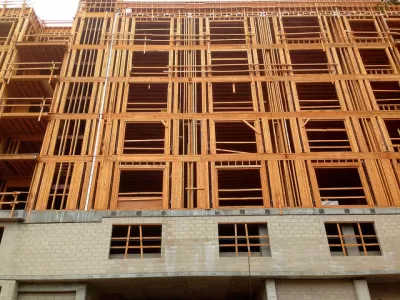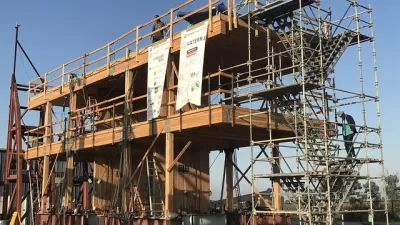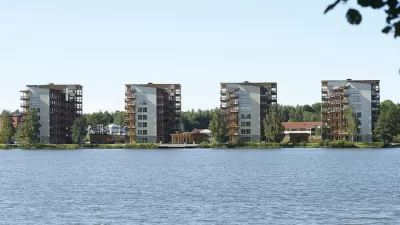A new kind of building will soon rise in the United States: the wooden tower. Extensive testing by the US Department of Agriculture and the timber industry will soon make timber viable for high-rise tower construction.

Although tall wood buildings in countries like Norway and Austria have made headlines around the world, mass timber, as this type of construction is known, has yet to make significant inroads here. Wood dominates low-rise residential construction in the US, but is absent in buildings more than five stories tall.
Many designers, timber industry representatives, and government officials are pushing for that to change. Their motivations vary. Mass timber offers incredible aesthetic benefits and could create new jobs in rural areas. It also holds tremendous potential to mitigate climate change. Carbon-heavy steel and concrete production accounts for almost 5% of the world’s greenhouse gas emissions. Mass timber products require no fossil fuels to produce — trees grow with solar energy alone — and can be replenished through sustainable logging and tree farms. As an added bonus, it can sequester carbon held in trees, preventing it from seeping into the atmosphere when they decay.
In 2014, the United States Department of Agriculture and timber industry partners, enthusiastic about the combination of new jobs and reduced greenhouse gas emissions, launched the U.S. Tall Wood Building Prize Competition. The contest offered $3 million to teams of designers and developers who pledged to build a mass timber tower at least 80 feet high.
FULL STORY: Fire-safety testing paves the way for timber towers

Study: Maui’s Plan to Convert Vacation Rentals to Long-Term Housing Could Cause Nearly $1 Billion Economic Loss
The plan would reduce visitor accommodation by 25,% resulting in 1,900 jobs lost.

North Texas Transit Leaders Tout Benefits of TOD for Growing Region
At a summit focused on transit-oriented development, policymakers discussed how North Texas’ expanded light rail system can serve as a tool for economic growth.

Why Should We Subsidize Public Transportation?
Many public transit agencies face financial stress due to rising costs, declining fare revenue, and declining subsidies. Transit advocates must provide a strong business case for increasing public transit funding.

How Community Science Connects People, Parks, and Biodiversity
Community science engages people of all backgrounds in documenting local biodiversity, strengthening connections to nature, and contributing to global efforts like the City Nature Challenge to build a more inclusive and resilient future.

Alabama: Trump Terminates Settlements for Black Communities Harmed By Raw Sewage
Trump deemed the landmark civil rights agreement “illegal DEI and environmental justice policy.”

Dear Tesla Driver: “It’s not You, It’s Him.”
Amidst a booming bumper sticker industry, one writer offers solace to those asking, “Does this car make me look fascist?”
Urban Design for Planners 1: Software Tools
This six-course series explores essential urban design concepts using open source software and equips planners with the tools they need to participate fully in the urban design process.
Planning for Universal Design
Learn the tools for implementing Universal Design in planning regulations.
City of Santa Clarita
Ascent Environmental
Institute for Housing and Urban Development Studies (IHS)
City of Grandview
Harvard GSD Executive Education
Toledo-Lucas County Plan Commissions
Salt Lake City
NYU Wagner Graduate School of Public Service




























